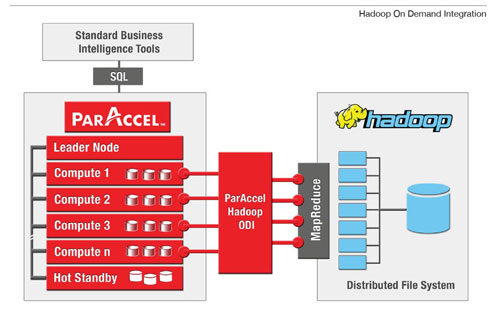Big Data Analytics
ParAccel Delivers a High-Performing Platform for Big Data Analytics

ParAccel offers a high performance analytic platform that runs complex analytics on big data across the entire enterprise. We spoke with CEO Chuck Berger about the challenges big data poses to enterprises, the business opportunities that analyzing big data provides, and how ParAccel’s platform enables organizations to better understand and grow through quick and effective data analysis.
For more information about ParAccel, visit their website and check out our review.

WEBSITE: www.paraccel.com
FOUNDED: 2005
LOCATION: Campbell, CA
SOLUTIONS: ParAccel Analytic Platform
How was ParAccel founded and what was its mission?
We were founded back in 2005 by a gentleman by the name of Barry Zane. Barry had been one of the original architects at Applix. His mission was to create the absolute highest performance database in the industry and to produce a product that was software only—meaning that it didn’t require specialized hardware to run on. But the driving mission was to be the absolute highest performance database. I joined almost exactly two years ago.
What motivated you to join ParAccel?
Really three things: First, I could see the beginnings of what we now call the big data market—that the volume and complexity of data was growing exponentially every day, as more and more data comes in from mobile devices, social networking, and traditional sources, like point of sales systems. It was clear to me there was a very large market opportunity as a result of that.
Secondly, our product was just coming into market, and it had already proven itself to be the highest performance product in the marketplace. So, I saw a big market and a very strong software technology to address that market.
And then finally, we have very good financial backing from four top drawer VCs, so I knew that we had the funding we would need to be successful.
Why do you think people should care about ParAccel?
Why they should care is that being able to leverage ever larger amounts of the data that exists in the world today to do in-depth analytics has already enabled a number of our customers to improve their business, either by increasing top line revenue growth through a better understanding of their customers or how their customers use their products, or through better understanding of their cost structure and being able to manage that better.
But people should care because being able to analyze data about their business and to do it in a timely fashion has proven itself to deliver positive revenue growth and profit growth for business as they’re learning how to use this new tool.
How is ParAccel different from other analytic database solutions in the market?
We’re different in two ways really: One, we are absolutely the performance leader. There are other people who make a similar analytic database, and we outperform the best of them by more than 10X and others by 50 to 100X. So, we definitely differentiate ourselves on performance.
Secondly, we differentiate ourselves in that most databases require you to do a significant amount of preparation before you can put the data in the database. We are what’s called “schema neutral,” so you do virtually no preparation on the data; you just load it into the database. And, that can often save hours of time and expensive additional storage and software licenses. We have what’s called “load-and-go,” which makes it very easy to bring up new data and do ad hoc analytics on that.
Then, the third reason they should care is that we’ve developed very sophisticated high speed connectors between ParAccel and existing databases, like Teradata or Hadoop or Oracle, so that they can move data back and forth between their existing database and our database for analytics very quickly, which allows them to substantially extend the value and life of their legacy investments.
What is the customer base for ParAccel, and how do these customers leverage your solutions?
We have about 50 customers. They’re large enterprises like Goldman Sachs; Office Max on the retail side; a number of intelligence agencies in the federal government; Yahoo on the online ad delivery side. So, our customers are large enterprises in financial services, retail, online media, and the government and the intelligence agencies. They’re using our technology to do exactly what I mentioned before: to understand their business better; to grow the business faster by understanding their customers and their products better; and to manage costs, including one type of cost for a number of our customers, which is risk management and fraud protection. One of our customers provides credit card fraud detection to a number of banks, and by using ParAccel, they increased their performance significantly over their legacy platform.
What disadvantages do businesses face if they ignore this growing need to analyze their data?
They’re going to find that their competitors will perform better than them—they’ll get more customers; they’ll get better pricing from their customers; shareholder value will go up faster because their revenues will grow faster than their competitors; and their profits will grow. Frankly, if done right, the cost to manage that large amount of data will be quite a bit less than their competitors. So, I think they’re just going to out-perform their competitors on almost every business venture.
How much does it cost to manage such large amounts of data?
Well, I’d question the answer because there are a lot of components to it. There’s networking costs to get the data moved from point of origin to where you’re going to store it; there’s storage costs; there’s server costs; there’s a variety of software that come to play. It’s safe to assume it’s a big number, but it’s hard to put an absolute dollar value on it because there’s so many pieces of it.
Gartner’s taken a shot at this in a piece they wrote last summer, where they defined this concept called the “logical data warehouse,” where they say if you don’t adopt the new technologies, your costs of managing data will be double that of people who do it and do it right; and in a couple of years, you will have a 20% advantage, in terms of revenue growth, customer retention, and profit margin versus your competition who don’t do it right.
Do you envision this as something that all companies will have to adopt and implement in order to stay competitive?
Absolutely. I think it affects every part of the business. We have a client in the networking business who’s taking all of the data from their clients’ networks and doing complex analytics on that, and then going back and recommending new product divisions and service offerings to help optimize for that client. We have clients that are managing their supply chain by running analytics on ParAccel. We have clients doing risk analysis for very large banks and trading strategies for very large banks. There’s almost no area in business where you can’t imagine that understanding the data better and in a more timely fashion isn’t going to help the business.
Big data is a fast-growing trend. What do you think has facilitated this rise in demand for solutions such as ParAccel?
Well, there’s two pieces: As I mentioned, the growth of data has been certainly engendered by the explosion in mobile devices. I no longer am just connected when I’m at my desk on my corporate network. I’m connected when I’m on an airplane. I’m connected in my car; and not only am I connected, but I’m able to transmit GPS information. Some people can know where I am, and they can target me based on knowing where I am.
Along with that, there’s been a huge explosion in data from social media. I was just reading an article about Facebook, where they do 2.5 billion pieces of content per day and take in more than 500 terabytes of data per day. So it’s clear that social media has added to the dramatic rise in the volume of data.
Then there’s other things we don’t think about. For instance, my car sends me an email every month, and there’s a lot of data about where I’ve been, whether my oil pressure is right, whether my tire pressure is right. They know a lot about me because they know I bought a certain type of car at a certain price point, and they can send ads to me based on that type of information.
Where do you see big data and the analytic database market headed in the next five years? How do you think ParAccel will fit into that landscape?
I think we’re very early in enterprises really understanding how to manage big data. Where I see big data going is getting bigger and bigger, ever faster. As that happens, customers are looking hard for ways to handle that data and gain competitive advantage by managing and analyzing that data better than their competitors. We see us continuing to enhance the performance to do that and being a leader in the big data industry as a result of that.
Do you see any big trends that could affect this market in the future?
Beyond the obvious, there’s going to be more and more data. Up until now, large enterprises have kept their data usually in what’s called a data warehouse, generally with a single vendor, whether it be Oracle or Teradata. I think what we’re going to see is a lot more hybrid solutions, where they will use a variety of platforms to manage and analyze their data, and pick which platform they use based on the particular workload that they have, and let that workload gravitate to the platform that performs best for them.
Who do you think are the most interesting companies in this market segment right now?
Well, I think one of the most interesting companies and a strong partner of ours is MicroStrategy, who has been a BI company in business for 20 years. Their CEO has had the vision to realize that business intelligence for social media is a really important and valuable tool for people in the future. They’ve recently developed a number of products—some of which use ParAccel as the foundation—that allow you to create business intelligence dashboards that help you understand social media activity around your company. For companies like Coke that have 30 million followers, there’s obviously data there that could be useful, and MicroStrategy has been the leader in providing tools that sit on top of a database like ours to help analyze those.
Who do you think are the most interesting people?
Given the data items that I mentioned and the valuation of the company, I would certainly say Mark Zuckerberg has done an incredible job of finding a way to collect a lot of data and beginning to find additional ways to monetize that data.
What’s next for ParAccel?
We have another major product release, which will come out early 2013 and will advance the performance even further. We’ll add a number of features, in particular, more connectivity to existing legacy databases. And then beyond that, we’re starting to look at how we handle unstructured data in a way that’s not possible today.
Ready to find the best BI software solution for your company? Browse product reviews, top blog posts and premium content on our BI resource center page. To compare the leading business intelligence software, download and browse the Top 10 Business Intelligence Software report for free.






